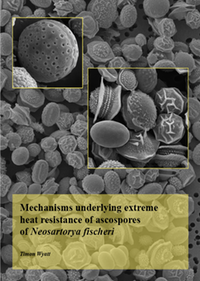
Mechanisms underlying extreme heat resistance of ascospores of Neosartorya fischeri
Promotie Universiteit Utrecht - Timon Wyatt
Hittebestendigheid sporen voedselbedervende schimmel ontrafelt
Promotie Universiteit Utrecht
Timon Wyatt onderzocht de mechanismen die ten grondslag liggen aan de (hitte)stressbestendigheid van ascosporen van de schimmelsoort Neosartorya fischeri.
Deze schimmelsoort komt voor in de bodem en kan op diverse levensmiddelen voedselbederf veroorzaken. Wyatt toonde aan dat de hittebestendigheid in N. fischeri toeneemt tijdens het rijpen van ascosporen. Zijn onderzoek biedt aanknopingspunten om de houdbaarheid van industrieel belangrijke micro-organismen, enzymen, vaccins, maar ook levensmiddelen te verlengen.
Wyatt toonde ook aan dat het eiwit LeamA betrokken is bij stressbestendigheid van ascosporen van N. fischeri. Twee Hsp12 eiwitten lijken een soortgelijke rol te vervullen.
Het begrijpen van de vorming en het functioneren van trehalose, TOS, mannitol, en hydrophilines zoals LeamA en Hsp12 biedt aanknopingspunten om voedselbederf door hittebestendige schimmels te voorkomen. Hierdoor zou de houdbaarheid van levensmiddelen kunnen worden verlengd. Ook zouden de stoffen trehalose, TOS, mannitol en de hydrophilines kunnen worden gebruikt om industrieel belangrijke micro-organismen, enzymen en/of vaccins te stabiliseren..
Food spoilage causes immense losses of food products worldwide and negatively affects human health due the production of toxic compounds, so-called mycotoxins. Worldwide economic costs related to fungal spoilage amounts billions of euro each year. Mild heat treatments are used to minimize fungal spoilage. As an example, pasteurized food products, especially canned fruit and fruit juices, are still prone to spoilage by fungi that produce extreme heat-resistant ascospores. Heat-resistant ascospores of Neosartorya fischeri survive more than 20 minutes at 85 °C. In fact, pasteurization can activate dormant heat-resistant ascospores to germinate and initiate spoilage of the food product. Knowledge of the mechanisms underlying heat-resistance of ascospores is of both fundamental and applied interest. Neosartorya fischeri was selected as the model system in this Thesis. It is a common and well-studied food spoilage agent and it is closely related to the human pathogen Aspergillus fumigatus.
In this Thesis, it has been shown that heat stress resistance of ascospores is gradually acquired during their development. Accumulation of compatible solutes (3.9 to 12.1 pg spore-1), increase of viscosity (5.4 to 21.2 cP) and reduction of bulk water is characteristic for the first phase of acquirement of stress resistance. The second phase is accompanied with an increase of trehalose and trehalose-based oligosaccharides (TOS)(see below), while the total concentration of compatible solutes and viscosity doesn’t change. It is also described that dry heat storage does not affect cytoplasmic mobility, but it does affect the redox stability in hydrophobic cytoplasmic environments.
Novel trehalose-based oligosaccharides (TOS) were identified in N. fischeri ascospores. These oligosaccharides consist of a trehalose core with one, two or three glucoses linked via an α-1,6 bond. TOS are found in ascospores of various species of the class Eurotiomycetes, but seem to be most abundant in the genera Neosartorya and Thermoascus. Synthesized TOS were less effective in protecting proteins and blastospores against heat and drought than trehalose. TOS inside the context of the cell may however be important for their functioning.
Inactivation of the gene mpdA, involved in mannitol synthesis, resulted in a strongly decreased level of mannitol in fruiting bodies (ascomata) and ascospores. Deletion of mpdA reduced mannitol levels to as low as 15 % of the wild type, whereas trehalose levels increased more than 400 %. Absence of mpdA had no effect on vegetative growth and formation of cleistothecia, irrespective of exposure to heat and oxidative stress. However, in the absence of the protein ascospore formation was completely absent.
Finally, the role of the hydrophilins LeamA, Hsp12A, and Hsp12B was assessed. Heterologous expression of these proteins in Escherichia coli resulted in increased tolerance against salt and osmotic stress. Purified LeamA, Hsp12A, and Hsp12B protected LDH against dry heat and freeze-thaw cycles. Deletion of leamA decreased the sensitivity of N. fischeri ascospores to dry heat. These results indicate that the three hydrophilins LeamA, Hsp12A, and Hsp12B are involved in the mechanism of heat resistant ascospores of N. fischeri.
Bestel dit boek direct bij de auteur.